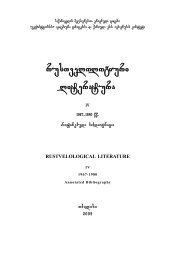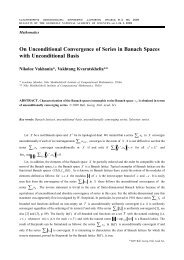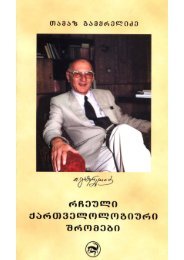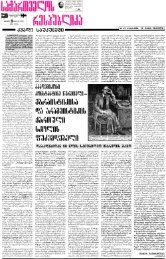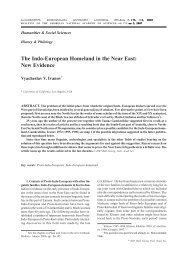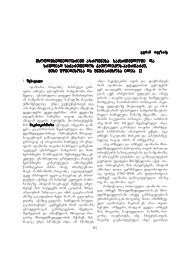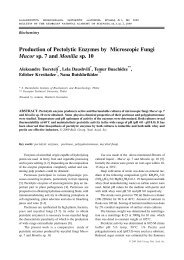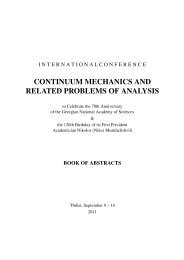Recent Trends in Nostratic Comparative Linguistics - The Georgian ...
Recent Trends in Nostratic Comparative Linguistics - The Georgian ...
Recent Trends in Nostratic Comparative Linguistics - The Georgian ...
You also want an ePaper? Increase the reach of your titles
YUMPU automatically turns print PDFs into web optimized ePapers that Google loves.
<strong>Recent</strong> <strong>Trends</strong> <strong>in</strong> <strong>Nostratic</strong> <strong>Comparative</strong> L<strong>in</strong>guistics 151<br />
<strong>Nostratic</strong> daughter languages. It may be noted here that, accord<strong>in</strong>g to Greenberg (1990), traces of an earlier system of<br />
vowel harmony can be discerned <strong>in</strong> Proto-Indo-European.<br />
It is unclear whether phonemic long vowels existed <strong>in</strong> Proto-<strong>Nostratic</strong> as well, though the evidence seems to<br />
<strong>in</strong>dicate that they did not, except <strong>in</strong> nursery words.<br />
F<strong>in</strong>ally, it may be noted that, while any vowel (*a, *e, *i, *o, *u) could appear <strong>in</strong> <strong>in</strong>itial syllables, only *a, *i, *u<br />
could appear <strong>in</strong> non-<strong>in</strong>itial syllables. This is identical to the pattern<strong>in</strong>g found <strong>in</strong> Dravidian.<br />
4.0. Root Structure Pattern<strong>in</strong>g <strong>in</strong> Proto-<strong>Nostratic</strong><br />
Comparison of the various <strong>Nostratic</strong> daughter languages makes it possible to determ<strong>in</strong>e the rules govern<strong>in</strong>g the<br />
structural pattern<strong>in</strong>g of roots and stems <strong>in</strong> Proto-<strong>Nostratic</strong>. Most likely, the earliest pattern<strong>in</strong>g was as follows (cf.<br />
Bomhard 2008.1:215–216 and 1:391–394):<br />
1. <strong>The</strong>re were no <strong>in</strong>itial vowels <strong>in</strong> Proto-<strong>Nostratic</strong>. <strong>The</strong>refore, every root began with a consonant.<br />
2. Orig<strong>in</strong>ally, there were no <strong>in</strong>itial consonant clusters either. Consequently, every root began with one and only<br />
one consonant. Medial clusters were permitted, however.<br />
3. Two basic root types existed: (A) *CV and (B) *CVC, where C = any non-syllabic, and V =any vowel. Permissible<br />
root forms co<strong>in</strong>cided exactly with these two syllable types.<br />
4. A stem could either be identical with a root or it could consist of a root plus a s<strong>in</strong>gle derivational morpheme<br />
added as a suffix to the root: *CVC+CV-. Any consonant could serve as a suffix.<br />
5. A stem could thus assume any one of the follow<strong>in</strong>g shapes: (A) *CV-, (B) *CVC-, (C) *CVC+CV-, or (D)<br />
*CVC-CVC-. As <strong>in</strong> Proto-Altaic, the undifferentiated stems were real words <strong>in</strong> themselves and could be used without<br />
additional suffixes or grammatical end<strong>in</strong>gs. However, when so used, a vowel had to be added to the stem (unless the<br />
stem already ended <strong>in</strong> a vowel or <strong>in</strong> a semivowel, nasal, or liquid), thus: (A) *CV- > *CV (no change), (B) *CVC- ><br />
*CVC+V, (C) *CVC-CV- > (no change), or (D) *CVC-CVC- > *CVC-CVC+V. Follow<strong>in</strong>g Afrasian term<strong>in</strong>ology, this<br />
vowel may be called a “term<strong>in</strong>al vowel” (TV). Not only did term<strong>in</strong>al vowels exist <strong>in</strong> Proto-Afrasian, they were also<br />
found <strong>in</strong> Dravidian, where they are called “enunciative vowels”. As <strong>in</strong> Proto-Dravidian, the term<strong>in</strong>al vowel was only<br />
required <strong>in</strong> stems end<strong>in</strong>g <strong>in</strong> obstruents, which could not occur <strong>in</strong> f<strong>in</strong>al position.<br />
<strong>The</strong> orig<strong>in</strong>al root structure pattern<strong>in</strong>g was ma<strong>in</strong>ta<strong>in</strong>ed longer <strong>in</strong> Proto-Dravidian and Proto-Altaic than <strong>in</strong> the<br />
other branches, while the pattern<strong>in</strong>g found <strong>in</strong> Proto-Indo-European, Proto-Kartvelian, and Proto-Afrasian is based<br />
upon slightly later developments. <strong>The</strong> root structure constra<strong>in</strong>ts found <strong>in</strong> Proto-Indo-European were an <strong>in</strong>novation.<br />
In Proto-Uralic, the rule requir<strong>in</strong>g that all words end <strong>in</strong> a vowel was an <strong>in</strong>novation and arose from the <strong>in</strong>corporation<br />
of the so-called “term<strong>in</strong>al vowel” <strong>in</strong>to the stem. It should be mentioned that reduplication was a widespread phenomenon.<br />
On the basis of the evidence of Proto-Indo-European, Proto-Kartvelian, Proto-Afrasian, Proto-Dravidian, and<br />
Proto-Altaic, it may be assumed that there were three fundamental stem types: (A) verbal stems, (B) nom<strong>in</strong>al and<br />
adjectival stems, and (C) pronom<strong>in</strong>al and <strong>in</strong>decl<strong>in</strong>able stems. Some stems were exclusively nom<strong>in</strong>al. In the majority<br />
of cases, however, both verbal stems and nom<strong>in</strong>al stems could be built from the same root. In Proto-<strong>Nostratic</strong>, only<br />
pronom<strong>in</strong>al and <strong>in</strong>decl<strong>in</strong>able stems could end <strong>in</strong> a vowel. Verbal and nom<strong>in</strong>al stems, on the other hand, had to end <strong>in</strong><br />
a consonant, though, as noted above, when the undifferentiated stems were used as real words <strong>in</strong> themselves, a<br />
“term<strong>in</strong>al vowel” had to be added to the stem (but only when the stem ended <strong>in</strong> an obstruent). <strong>The</strong> term<strong>in</strong>al vowels<br />
were morphologically significant. Adjectives did not exist as an <strong>in</strong>dependent grammatical category <strong>in</strong> Proto-<strong>Nostratic</strong>.<br />
Dur<strong>in</strong>g the earliest period of Proto-<strong>Nostratic</strong>, roots could only have the forms: (A) *CV- and (B) *CVC-. Type<br />
(A) was restricted to pronom<strong>in</strong>al stems and <strong>in</strong>decl<strong>in</strong>ables, while type (B) characterized nom<strong>in</strong>al and verbal stems. A<br />
s<strong>in</strong>gle derivational formative could be placed after root type (B): *CVC + CV (derivational formative). Grammatical<br />
relationships were <strong>in</strong>dicated by plac<strong>in</strong>g particles either after the undifferentiated stem or after the stem plus a derivational<br />
formative: (A) *CVC + CV (particle [P]) or (B) *CVC + CV (derivational formative [DF]) + CV (particle<br />
[P]). In this scheme, a morphologically significant formative vowel (FV) had to be added either directly after the root<br />
if it ended <strong>in</strong> a consonant or between the root and any follow<strong>in</strong>g element, be it particle or derivational formative;<br />
thus, we get the follow<strong>in</strong>g patterns:<br />
(A) *CVC + V FV<br />
(plus particle: *CVC + V FV<br />
+ CV P<br />
)<br />
(B) *CVC + V FV<br />
+ CVDF (plus particle: *CVC + V FV<br />
+ CV DF<br />
+ CV P<br />
)<br />
(C) *CVC-CVC + V FV<br />
(plus particle: *CVC-CVC + V FV<br />
+ CV P<br />
)<br />
Bull. Georg. Natl. Acad. Sci., vol. 2, no. 4, 2008





